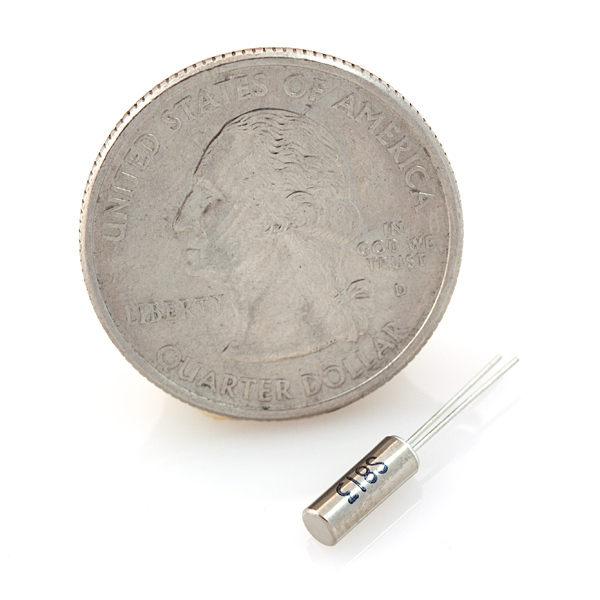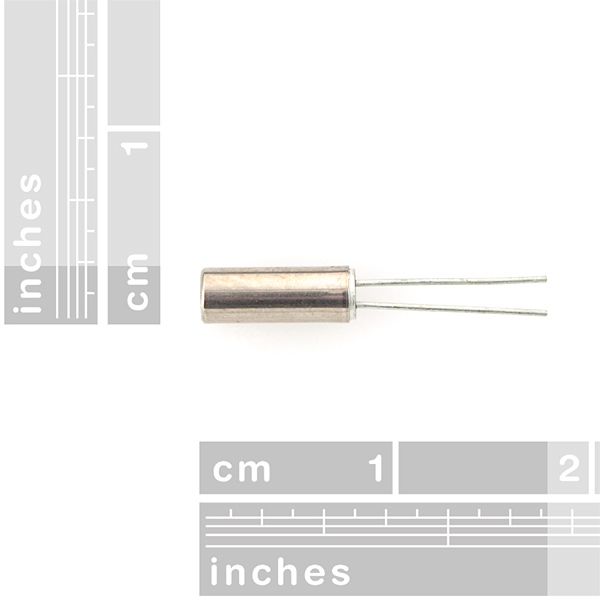Standard 'Watch' or Real-Time-Clock crystal. 32.768kHz means it is precisely half of a 16-bit counter. Start counting at 0x8000 (or 32768). When the counter rolls over from 65535 to 0, then you know that exactly one second has passed. Reset the interrupt, reset the counter, and start counting again! Rated at 12.5pF load capacitance, 35K ohm max (18K ohm typical) series resistance, and +/- 20ppm stability. Small cylinder package.
Crystal 32kHz Product Help and Resources
Core Skill: Electrical Prototyping
If it requires power, you need to know how much, what all the pins do, and how to hook it up. You may need to reference datasheets, schematics, and know the ins and outs of electronics.
Skill Level: Competent - You will be required to reference a datasheet or schematic to know how to use a component. Your knowledge of a datasheet will only require basic features like power requirements, pinouts, or communications type. Also, you may need a power supply that?s greater than 12V or more than 1A worth of current.
See all skill levels
Comments
Looking for answers to technical questions?
We welcome your comments and suggestions below. However, if you are looking for solutions to technical questions please see our Technical Assistance page.
Customer Reviews
No reviews yet.



0x80 = 128. You meant to type 0x8000.
There is a much more efficient way to determine when each second has elapsed. Instead of interrupting every 30.5uS like what is suggested in the item description, use the features built into the microcontrollers to minimize the resources needed to do this.
For example, if you connect this crystal to the TOSC1/2 pins in an AVR microcontroller and then configure TIMER0 to use that clock instead of the main system clock, it can be divided to give different interrupt frequencies. Enabling the TIMER0 overflow interrupt and running it with a prescaler of 1 will interrupt every 1/128 seconds (7.8125ms). If you change the prescaler to 128, it will interrupt at exactly 1 second. Doing it this way will reduce your power consumption by an incredible amount if you are using it as a real time clock. It will also require much less processing time as it is only interrupting at 1Hz instead of 32.768KHz.
Even better: on the ATmega48/88/168/etc. series, Timer2 can run in asynchronous mode, which allows you to shut down virtually the entire chip while this watch crystal is humming away on the TOSC1/2 pins, saving lots of energy on battery-powered projects. Timer2 will easily wake up the chip again when the desired interrupt conditions are met. For portable clock or remote wireless node applications, this is really helpful. Unfortunately, the Timer2 chapter of the mega's datasheet isn't up to Atmel's usual high standard of readability. Here's how I made it work (C language for gcc):
//somewhere in main():
ASSR = 0x20; //enable timer2 async mode with an external crystal
_delay_ms(250); //let external 32KHz crystal stabilize
TCCR2B = 0x05; //set the prescaler to 128: 32.768kHz / 128 = 1Hz overflow
TIFR2 = 0x1; //reset timer2 overflow interrupt flag
TIMSK2 = 0x01; //enable interrupt on overflow
SMCR = 0x03; //use power-save mode when we sleep
sei(); //enable all interrupts
//this is a skeletal main loop. To save energy, the chip only wakes up
// every second, does some chores, then goes back to sleep again.
// The 32KHz crystal on the TOSC1/2 pins wakes it up every second.
while(1)
{
sleep_enable();
sleep_mode(); //Timer2 overflow interrupt will wake us from sleep
sleep_disable();
//do other work here, now that we're awake, such as updating an LCD
}
//...not in main()...
ISR(TIMER2_OVF_vect) //Timer 2 overflow interrupt handler
{
//This executes every second. Update real-time clocks,
// listen for/broadcast wireless packets, etc.
}
Upon further inspection, I realized the suggested interrupt routine in the item description isn't interrupting at 32.768KHz, but it does require an unnecessary amount of overhead as a prescaler can often be used to generate exactly 1 second overflows of an 8 bit counter.
I demand a cleaner Quarter!
For too long have we endured this unsightly coin in our product Pics... This is Heresy.
Is it ok to use the 22pf capacitors that SparkFun caries to load this? I've heard that it's ok but I've also heard that it can hurt the crystal.
I have a 16Mhz crystal rated at 12pf that I use when I'm breadboarding, it has worked fine with 22pf caps and I've run it for a total of at least a month (ran it continuously for a week straight once.) It still works fine so I think its ok but I'm not sure.
Please note if you plan to use these on the teensy it is much to long for it to fit easily!
Anyone knows if this would be suitable for the real clock on the Teensy 3.0?
This generates a square wave, right?
Is it ok to use the 22pf capacitors that SparkFun caries to load this? I've heard that it's ok but I've also heard that it can hurt the crystal.
I have a 16Mhz crystal rated at 12pf that I use when I'm breadboarding, it has worked fine with 22pf caps and I've run it for a total of at least a month (ran it continuously for a week straight once.) It still works fine so I think its ok but I'm not sure.
EDIT: Oops! Didn't mean to post that twice
+- 20ppm over what temperature range. A data sheet explaining this could give me the confidence needed to use this part.
A data sheet for PIC's says that the cheap 32k watch crystals are typically good to -10C. Not sure what there definition of cheap is and if crystal is cheap or non cheap.
Data Sheeeet????
http://www.ecsxtal.com/store/pdf/ECS-3x8.pdf
This is for the 3x8
Noob question: Can this crystal be installed in any direction? On other words, is there any polarity to be considered?
-AC
Nope, no polarity. Unlesssss it has an internal diode, which it doesn't.
Is this one of those watch crystals purposely designed to be 'fast'?
I ask because the crystals for cheap watches are often designed to run at a consistent rate but fast, so that the counter overflow can be easily calibrated electronically during assembly (instead of doing all of the expensive mechanical trimming that you would need to get 32768Hz out of the component).
Crystal usually have their frequency on them, right? I ordered one of these and across the top it says "4.000N" which sounds a lot like a 4Mhz crystal rather than 32.768khz.
Is there any chance of a datasheet for this?
I assume this crystal is used on the DEV-09734 BoB?
Noob question. Can I use this as an external clock for an ITG-3200? I have a DS3234 but I am thinking that is overkill.
Is there a datasheet or a eagle part avalible that I can use to lay this out on a board?
Yea it's in the SparkFun library under CRYSTAL.
i used one of these in a tube clock of mine .. i have had to update the time only once and that was after my backup battery failed